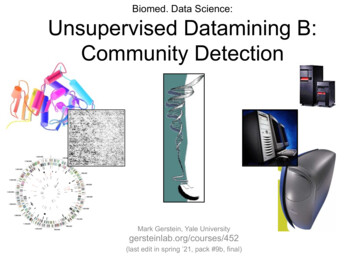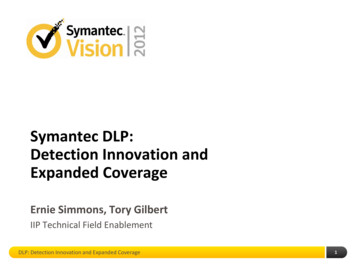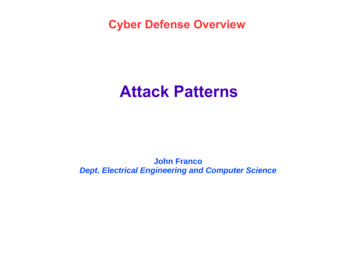
Transcription
ISSN: 2277-9655Impact Factor: 4.116CODEN: IJESS7[Mohammed* et al., 6(6): June, 2017]IC Value: 3.00IJESRTINTERNATIONAL JOURNAL OF ENGINEERING SCIENCES & RESEARCHTECHNOLOGYBRUTE FORCE ATTACK DETECTION AND PREVENTION ON A NETWORKUSING WIRESHARK ANALYSISMustapha Adamu Mohammed*, Ashigbi Franlin Degadzor, Botchey Francis Effrim,Kwame Anim Appiah*Department of Computer Science, Koforidua Technical University, Koforidua, GhanaDepartment of Computer Science, Koforidua Technical University, Koforidua, GhanaDepartment of Computer Science, Koforidua Technical University, Koforidua, GhanaDepartment of Computer Science, Koforidua Technical University, Koforidua, GhanaDOI: 10.5281/zenodo.802797ABSTRACTBrute-force attacks are a prevalent phenomenon that is getting harder to successfully detect on a network leveldue to increasing volume and encryption of network traffic and growing ubiquity of high-speed networks.Although research in this field has advanced considerably, there still remain classes of attacks that areundetectable. Since no security measure can guarantee that an attacker will not succeed eventually, intrusiondetection techniques should be applied to detect anomalous behavior early and minimize its impacts on networkperformance caused by the intruders. This research proposed an intrusion detection technique in which the node(server) uses a monitoring software application to monitor the traffic flow on the network and collects relevantstatistics about it. By analyzing and comparing the traffic information, the administrator will be able to indicate ifany attack is performed or not.KEYWORDS: Brute- Force, Wireshark, network, FTP Server.INTRODUCTIONInformation and network systems can be open to attacks even if some finest technological measures such asfirewall and antivirus are put in place. The reason is that information security is not limited to some of thetechnological aspect but also other detection techniques which gives accurate analysis. Brute force attacks areused for detecting login credentials using random combinations of username and passwords. This researchdemonstrates a technique by which brute force attacks on FTP servers can be detected using Wireshark Analysis.In recent years, network security research started focusing on flow-based attack detection in addition to the wellestablished payload-based detection approach. Instead of only looking for malicious activity in the actual packetdata, network Flows are also considered for analysis. This is not surprising since the amount of data one has tofight with is drastically reduced and the attacks visible in flow data tend to complement the attacks that we striveto find in network payload. We propose a detection technique and shed light on the shortcomings inherent to theflow-based attack detection approach. This research aims at demonstrating a technique by which brute forceattacks on FTP servers can be detected using Wireshark Analysis. The research seeks to realize the followingobjectives: Response Codes Logged in attempts; Nature of End-Product with the number of login attempts. Information on the initiator of the attack.LETERATURE SURVEYSeveral studies have identified areas of vulnerability in information assets of organizations using some detectionmethods or techniques, however our research seeks to look at securing network data from the point of detectiontechnique using Wireshark in conjunction with FTP server. Smith, (2004) conducted a test to show how data areinsecure in organizations. He performed an information security review of publicly accessible servers of the GIACenterprise. The methodology he used was to examine the public servers from both the network perspective as wellas from the local host perspective. The findings of the assessment include:http: // www.ijesrt.com International Journal of Engineering Sciences & Research Technology[26]
ISSN: 2277-9655Impact Factor: 4.116CODEN: IJESS7[Mohammed* et al., 6(6): June, 2017]IC Value: 3.00 Operating systems are not up to date with the latest system updates and security updates.The apache server is vulnerable to attacks and is running default configurationThe Domain Name System (DNS) server has not been locked down.The File Transfer Protocol (FTP) server authenticates users using insecure methods.The mail server authenticates users in clear-text when encrypted methods are available. The conclusionwas that the information assets of the organization are vulnerable and data and information are insecure.A similar test was carried by Honeywell’s Industrial IT Solutions (2012) in an attempt to help AmerChemcompany better understand their current cyber security situation, the potential risks associated with that currentstatus, and a proposed path put forward to remediate any issues. The scope of the audit was all cyber assets at theAmerChem facility. In total, thirty-nine (39) servers and workstations were audited. The findings were that Cyberassets have not been patched since their installation dates; Default Guest accounts is enabled on a number of cyberassets; There are early indications of hard drive failure on one cyber asset; One cyber asset is connected to boththe process control network and the business network; and Cyber assets are not up to date, or do not have anymalicious software prevention solution in place.Silver, (2013), James et al. (2009), Philip et al. (2003) and Anita, Kavita and Kiraandeep (2013) have followedthe same trend on concentrating vulnerability evaluation on hardware aspect of information assets and using somedetection mechanisms but then again the Wireshark detection factor is short of which this research will address.Studies have been undertaken to identify some of the weaknesses and vulnerabilities in most commonly usedcryptographic algorithms. Though studies on cryptosystems vulnerabilities and this research are related, one ispurely technical and some software based detections and the other focuses on the Wireshark aspect of detection.One of the major areas of information security weakness discussed in literature is on database vulnerabilities.Here again, the vulnerabilities are software and hardware related. The human factor has been glossed over.Shulman (2006), outlines ten vulnerabilities associated with database infrastructures but none of them talked aboutthe activities end users do that make information systems vulnerable to attacks and some other effective detectiontechnique to these attacks.In today's businesses, database technologies are needed more than before and with the increasing usage of theinternet for business, threats or risks to these databases are growing. Lamar (2012) opines that database attacksare prevalent these days because of the following vulnerabilities: Vulnerabilities in Operating Systems like Windows, UNIX and Linux and their services associated withthe databases could create a loophole for illegal access which may lead to a Denial of Service (DoS)attack. Database rootkits: A database rootkit is a program or a procedure that is hidden inside the database andthat gives the administrator special privileges to be able to access data in the database. Sometimes therootkits turn off alerts prompted by Intrusion Prevention Systems (IPS) which could be disastrous. Weak authentication: Weak authentication models permit attackers to use tactics like social engineeringand brute force to get hold of database login details of users.Weak audit trails: A weak audit logging method in a database server is risky to an institution particularly in retail,financial, healthcare, and other businesses with strict regulatory observance. PCI, SOX, and HIPAA are rules thatrequire extensive logging of actions and also generate events when something goes wrong. In order to resolveissues when something goes wrong, logging to critical transactions in a database must be done in an automatedway. Audit trails work as the last line of database defence and can sense any violation. Audit trails can help traceback the violation to a particular period and a particular user.This research will add to the literature by looking at a different angle to information systems detectionmechanisms, thus, targeting only the use of Wireshark to detect brute force attacks. Finally, Firewallvulnerabilities have also been discussed in literature. Firewalls guard a trusted network from an untrusted networkby filtering traffic by following a designated security policy. Different firewalls are being used today and they areone of the sources of security vulnerabilities. Kamara et al. (2010) give a taxonomy to understand firewallvulnerabilities in the framework of firewall implementations as it is not practical to study and test each firewallfor all possible problems. They examined firewall attributes, and cross reference each firewall operation withcauses and effects of flaws in that operation, evaluating twenty recognized flaws with existing firewalls. Theoutcome of their investigation is a set of matrices that demonstrate the distribution of firewall vulnerability causeshttp: // www.ijesrt.com International Journal of Engineering Sciences & Research Technology[27]
ISSN: 2277-9655Impact Factor: 4.116CODEN: IJESS7[Mohammed* et al., 6(6): June, 2017]IC Value: 3.00and effects over firewall operations. These matrices are beneficial in circumventing and perceiving unforeseenhitches during both firewall implementation and firewall testing. Firewalls can be software or hardware andvulnerability studies in them are classified according to the vulnerabilities in the software, the hardware andvulnerabilities due to misconfiguration (Kashefi, et al, 2013).But the loyalty of the networks is the matter of concerned. Since no security measure can guarantee that an attackerwill not succeed eventually, intrusion detection techniques should be applied to detect anomalous behavior earlyand minimize its impacts on network performance caused by the intruders. We have proposed an intrusiondetection technique in which the node (server) uses a monitoring software application to monitor the traffic flowon the network and collects relevant statistics about it. By analyzing and comparing the traffic information, theadministrator will be able to indicate if any attack is performed or not.WHY WIRESHARK?Wireshark is an open-source protocol analyzer designed by Gerald Combs that runs on Windows and Unixplatforms. Originally known as Ethereal, its main objective is to analyze traffic as well as analyzingcommunications and resolving network problems. Wireshark implements a range of filters that facilitate thedefinition of search criteria and currently supports over 1100 protocols (version 1.4.3), all with a simple andintuitive front-end that enables you to break down the captured packets by layer. Wireshark "understands" thestructure of different networking protocols, so you are able to view the fields of each one of the headers and layersof the packets being monitored, providing a wide range of options to network administrators when performingcertain traffic analysis tasks.METHODOLOGYThis research employed an experimental approachExperiment:The purpose of this test was to display or exhibit how brute force attacks on FTP servers can be detected alongsideusing Wireshark analysis. The method used was: brute force attack.Brute Force AttackBrute force attempts were made to reveal how Wireshark could be used to detect and give accurate login attemptsto such attacks. To do this, the admin ftpserver interface was accessed.FTP server (Filezilla server), which is an open source (third party) software, was used for the test. The FilezillaFTP server was found to be running on port 21.Figure 1 FTP Server (Filezilla Server) InterfaceFigure 1 above represents the initial interface of the filezilla FTP server when launched and logged on.http: // www.ijesrt.com International Journal of Engineering Sciences & Research Technology[28]
ISSN: 2277-9655Impact Factor: 4.116CODEN: IJESS7[Mohammed* et al., 6(6): June, 2017]IC Value: 3.00Figure 2 Creating a Directory for User AccountsCreating the directoryGo to: edit and click on groups on groups interface click on shared folders click on "Add" and choose where you would want to save you AccountsFigure 3 Creating Groups to Categorized UsersTo Create a Group: Select the directory created under Groups at the right-side, click "Add" Enter the group name and click "ok"Now Give the Group the necessary Permissions and click okay to savehttp: // www.ijesrt.com International Journal of Engineering Sciences & Research Technology[29]
ISSN: 2277-9655Impact Factor: 4.116CODEN: IJESS7[Mohammed* et al., 6(6): June, 2017]IC Value: 3.00Figure 4 Creating Users in the Ftp ServerTo Add a User: Hover the mouse pointer to Edit on the FileZilla FTP Server and click on users Click on "Add" and enter the name of the user At the drop down Menu are the various Groups Created. Assign the user to the appropriate groups and click "ok" Now check the Password Box and Enter the password of the user Click okay to save settingsLab Components Hardware Windows system with FTP Server. Windows system. Switch Software WiresharkFtp server was downloaded and installed onto the server.Installation and setup for ftp server Run the exe installer Select admin port and remember this port Launch FileZilla Server Interface Enter port from above, enter (new) password for administration, click ok/connect Create a user and/or group with permissions to a home directory. Add additional directory and set the alias name to display within home directory (e.g. /Alias Name)CompleteUser accounts with administrative rights were created on the ftp serverThese accounts do perform different administrative tasksLab Setup The lab topology used is shown below.http: // www.ijesrt.com International Journal of Engineering Sciences & Research Technology[30]
ISSN: 2277-9655Impact Factor: 4.116CODEN: IJESS7[Mohammed* et al., 6(6): June, 2017]IC Value: 3.00Figure 5 Setup of the lab used for experimentWindowsWindows with FTP server And wiresharkIp: 192.168.2.5Mask: 255.255.255.0ip: 192.168.2.2Mask: 255.255.255.0We chose windows for both server and attacker system The PC’s were connected to the switch and configured with the IP addresses as shown in the previousslide. The PC with the IP address, 192.168.2.5 was used as the attacker’s system. The PC with the IP address,192.168.2.2 served as the FTP server. Net-Kit FTP server was installed along with wireshark on the FTP server system. (Any FTP server whichis compatible on windows was used.)RESULTS FROM EXPERIMENTBrute Force AttackThe experiment also found out that the system is vulnerable to brute force attacks. A brute force attack is a trialand-error method used to obtain information such as a user password or personal details. In this attack a software(Filezilla ftp client) was used to generate a large number of consecutive guesses as to the value of the desired data.FTP Analysis after incorrect password Wireshark is started on the FTP server. A FTP connection is initiated from the FTP client (attacker system) to the FTP server. The command ftp192.168.2.2 is provided on Windows. After the above command is initiated, the username and password to log into the system is provided. To analyze the behavior of incorrect password on the server, a wrong password is provided to connect tothe server. Wireshark is filtered for FTP traffic. The screenshot is shown in the following slidehttp: // www.ijesrt.com International Journal of Engineering Sciences & Research Technology[31]
ISSN: 2277-9655Impact Factor: 4.116CODEN: IJESS7[Mohammed* et al., 6(6): June, 2017]IC Value: 3.00Wireshark Analysis of FTP with incorrect passwordFigure 6: Wireshark analysis of FTP on incorrect passwordWireshark Analysis of FTP with incorrect password When the incorrect password is sent from the client, the FTP server responds with ‘Login Incorrect’message. FTP servers respond with a specific response code which is 530 when the login is incorrect which isshown in the previous slide. This response code can be used for detecting incorrect login attempts on the server.Brute force detection technique FTP servers respond with a specific response code which is 530, when an incorrect password is provided. Wireshark filter can be used to monitor packets which have the specific FTP code. This would provide details on the number of login attempts made by a specific IP address, which wouldhelp to analyze a brute force attack.Brute force simulation Wireshark is started on the FTP server.Multiple login attempts with incorrect username and password is initiated from the attacker system(192.168.2.5) to the server. The Wireshark on the server is filtered with the code ftp.response.code 530, which would filter allincorrect login attempts on the server. The screenshot is shown in the following slide.http: // www.ijesrt.com International Journal of Engineering Sciences & Research Technology[32]
ISSN: 2277-9655Impact Factor: 4.116CODEN: IJESS7[Mohammed* et al., 6(6): June, 2017]IC Value: 3.00Figure 7 Wireshark filter for brute force detection interfaceUsing Wireshark Filter for Brute Force Detection It can be observed that Frame no 111, 1062, 1085 responds with the 530 error message. If the number of incorrect login attempts exceeds 3, it indicates a brute force attack. The destination IP address would also provide information on the initiator of the attack, which in thiscase is 192.168.2.5.Figure 8 Frame number and response codes of Wireshark analysishttp: // www.ijesrt.com International Journal of Engineering Sciences & Research Technology[33]
ISSN: 2277-9655Impact Factor: 4.116CODEN: IJESS7[Mohammed* et al., 6(6): June, 2017]IC Value: 3.00No single indicator is certain, but these are all logical possibilities: Many failed log-ins from the same IP address. This is a particularly strong sign (though if the attacker isusing a botnet, IP addresses will obviously vary). Logins with multiple username attempts emerging from the same IP address Logins for a single account coming from many different IP addresses Failed login attempts from alphabetically sequential usernames or passwordsWhat to do after Detecting a Brute Force AttackThe FileZilla FTP Server has a feature called “Automatic ban”. However, the automatic ban mechanism couldonly work after we enabled it first.Figure 9 Initiating the Auto Ban mechanismBut this feature is not sufficient mechanism since an attacker can change his/her IP to start a new attack.The best way to do this is to disable the user accounts being brute forced.Process: Click on “Edit” Hover to users and click on it Select the accounts that is being attacked Uncheck the Enable account and click “Ok”The process of disabling the user accounts is shown in the figure below.http: // www.ijesrt.com International Journal of Engineering Sciences & Research Technology[34]
ISSN: 2277-9655Impact Factor: 4.116CODEN: IJESS7[Mohammed* et al., 6(6): June, 2017]IC Value: 3.00Figure 10 Disabling a user account (after an attack is been detected)FINDINGSHuman factor vulnerabilities in information securityThe following are human factor vulnerabilities that emerged during the experiments. These threats andvulnerabilities include acts performed without intent or malicious purpose by an authorized user (respondents).When people use information systems, sometimes improper usage happens. Inexperience, improper training, andthe making of incorrect assumptions are just a few circumstances that can cause these vulnerabilities.Lack of mechanism to lock users after several login attemptsThe system seems to have a weak lock out mechanism or none at all. This was apparent during the experimentwhen several passwords were gathered through brute force attack. A measure such as blocking a user after severalattempts can be used to allay brute force password guessing attacks. In such measures, accounts are usuallyblocked after three to five unsuccessful login attempts and can only be unblocked after a given period of time,through an unlock system, or intercession by an administrator. Account lockout systems should offer a balancebetween protecting accounts from illegal access and guarding users from being denied authorized access.Leaving computers unattended toComputers which have been left idle and unattended to can pose a threat to data as do other threats. This givesroom to unauthorized accesses which can facilitate access to sensitive data and email messages.This study shows that majority of the respondents (55.43%) will leave their computers idle when leaving the workpremises. Again, majority of them (67.39%) will leave their computers unattended to when attending meetingsand 81.52 % will not log off their computers when visiting the washroom. These actions put data at risk especiallythe risks of insider attacks associated with employees leaving their PCs unattended with active sessions running.A significant number of unauthorized access events may occur when someone sits down at another user'scomputer.Connecting to networks outside the corporate infrastructureConnecting to a private or a public network other than the corporate network infrastructure can pose a seriousthreat to data when the device used to connect is compromised. A device which has been compromised could beused as a gate way to a corporate infrastructure. Workers who connect their mobile devices to the home networkcould expose their devices to attacks, as the devices are outside the perimeter of the more secured corporatenetwork. One of the IT personnel interviewed states that attackers could launch a silent attack against any deviceconnected outside a corporate’s network when it is inactive pending the device to connect back to the corporatehttp: // www.ijesrt.com International Journal of Engineering Sciences & Research Technology[35]
ISSN: 2277-9655Impact Factor: 4.116CODEN: IJESS7[Mohammed* et al., 6(6): June, 2017]IC Value: 3.00network. This allows the attacker to gain access to the network from the inside because the network will considerthe devices as trusted ones as they are already associated with the network.Remote worker securityOne of the dangerous ways of exposing data to attacks is by forwarding them to home. This activity can turn allof the security measures in an institution into a completely useless process. Workers have the tendency to move anon-finished work to their devices and personal computers at home so that they could work on it later at home.This is quite risky because often personal computers and devices are less secured compared to the corporate ones.While business operations become more and more dispersed and online, mobile workers increase the potentialthreat for data. One of the IT professionals indicated that improper handling of data such as moving files from anoffice device to a home computer that does not have proper IT security measures attracts information theft.CONCLUSIONThe research has established that despite the fact that technology is important in the information securityframework, some detection technology alone was not enough to keep an organization secure from data breaches.Wireshark analysis needed to be factored in to make the security framework holistic.Again, the research revealed that it is not enough to say that the role of people is to run the applications. Peoplecan either be the weakest or the strongest link in the security framework and therefore should compensate for thedeficiencies in the available security technology. Therefore, there is the need to bring IT and human securitytogether under a true information security management system.Moreover, the increasing reliance on some technological components of information security, makes securinginformation system increasingly challenging. Quite a number of the security problems emanate from humansbecause humans have the tendency to show their unethical attitudes when using information systems. Humans aretherefore critical part that, when ignored, could affect information security efficiency.Improving security using technical means is important for organizations conducting business online as well as fororganizations that are at the same time seeking to realize their missions and goals. However, implementingtechnical measures does not guarantee a more secure environment. All sorts of human factors can severely affectthe management of security in personal and organizational setting.Therefore, security is in the aspect of FTP servers needs more and better detection technique such as Wiresharkanalysis to enable us put better security measures in place.RecommendationsWe recommend that administrators must use Wireshark to analyze the network traffic in order to be able to readinformation about every packet.Administrators must disable a user account instead of putting a lock on an account for a period of time. Disablingthe account would prevent access to the account forever unless the authorized user of the account sees theadministrator for reactivationBased on the findings of the study, it is recommended that for the human factor in information security be managedeffectively, the following should be taken into consideration; Security awareness: Security consciousness and education are some of the most successful measures tomitigate the human factor threats to information security. In that regard, any information security planshould include a needs assessment that entails collecting information on the existing processes, theknowledge that is required of workers, and the cracks in the current information security. Endpoint Security: Quite a number of information in institutions is not centralized. Where there arecentralized systems, information is often shared among workers and copied to different devices.Endpoint security is the notion that each device in an organization needs to be secured. It isrecommended that sensitive information on portable devices like laptops and tablets should beencrypted. In addition, removable storage such as DVD drives and USB ports may be blocked if theyare considered to be a major threat path for malware infections or data leakage. To secure endpoints,one needs extensive planning like applying policies that state that only certain computers like laptopscan connect to particular networks. Usage of wireless (WiFi) access points should also be restricted.http: // www.ijesrt.com International Journal of Engineering Sciences & Research Technology[36]
ISSN: 2277-9655Impact Factor: 4.116CODEN: IJESS7[Mohammed* et al., 6(6): June, 2017]IC Value: 3.00ACKNOWLEDMENTThe authors wish to acknowledge the efforts of all the sources of reference for this work.REFERENCE[1] Anita, G., Kavita, K. and Kirandeep, K. (2013), Vulnerability assessment and penetration testing.International Journal of Engineering Trends and Technology 4 (13).[2] Honeywell’s Industrial IT solutions (2012), Amerchem cyber security vulnerability assessment[3] James, A. K., Barton P. M., Eduardo, C. and Elisa, H. (2009), “First principles vulnerability .pdf), (accessed 2014 February 21)[4] Kashefi, I., Kassiri, M., and Shahidinijad, A. (2013), A survey of on security issues in firewall: a newapproach for classifying fire wall vulnerabilities. Internationla Journal of Engineering Researh andApplications (IJERA) 3 (2). pp. 585-591[5] Kamara, S., Fahmy, S., Schultz, E., Kerschbaum, F., and Frantzen M. (2010), “Analysis of vulnerabilitiesin internet firewalls,” wall-analysis.pdf), (accessed2014 March).[6] Lamar, A. (2012) “Types of threats to database security,” ticles/61402.aspx), (accessed 2014 March 18)[7] Mitnick, K.D. and Simon, W.L. (2002). The Art of Deception: Controlling the Human Element,Indianapolis: Wiley Publishing Inc.[8] Shulman, A. (2006), Top ten database security threats. Foster City, CA: Imperva Inc.[9] Silver, P. (2013), Vulnerability assessment with application security. WA: F5 Networks, Inc.[10] Smith, R. D. (2004), Public servers’ vulnerability assessment report. Swansea: SANS InstituteCITE AN ARTICLEMohammed, M. A., Degadzor, A. F., Effrim, B. F., & Appiah, K. A. (2017). BRUTE FORCEATTACK DETECTION AND PREVENTION ON A NETWORK USING WIRESHARKANALYSIS. INTERNATIONAL JOURNAL OF ENGINEERING SCIENCES & RESEARCHTECHNOLOGY, 6(6), 26-37. doi:10.5281/zenodo.802797http: // www.ijesrt.com International Journal of Engineering Sciences & Research Technology[37]
demonstrates a technique by which brute force attacks on FTP servers can be detected using Wireshark Analysis. In recent years, network security research started focusing on flow-based attack detection in addition to the well-established payload-based detection approach. Instead of










